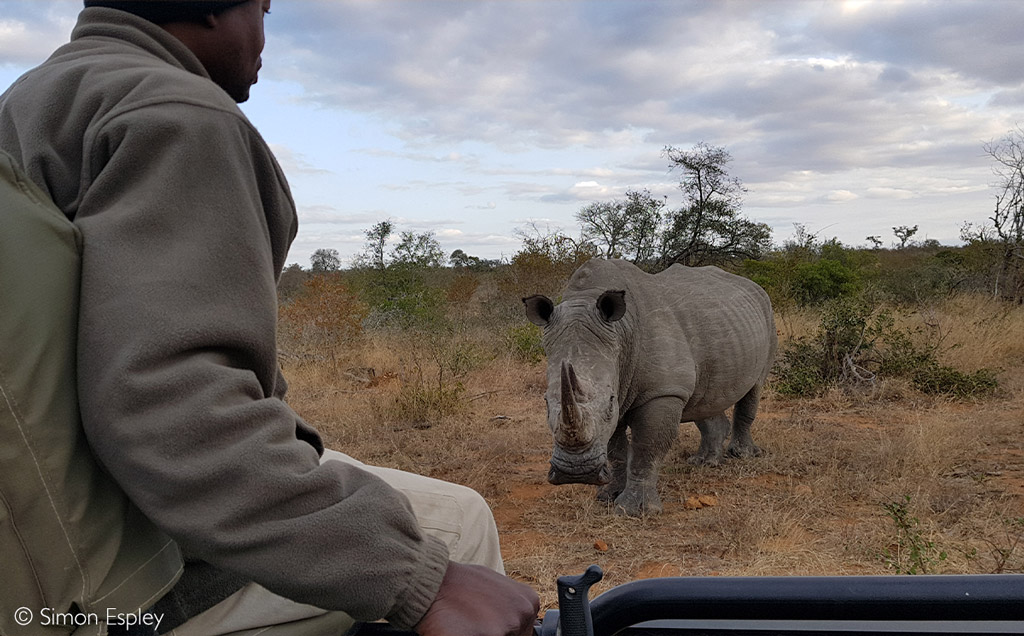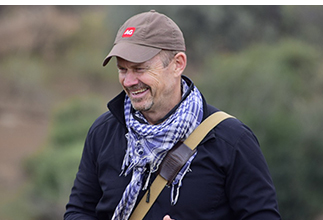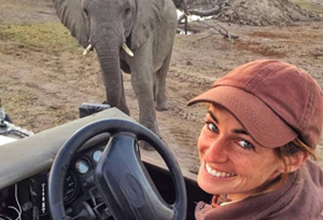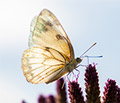
This is a copy of our weekly email newsletter. Subscribe here to receive the newsletter.
Kruger’s declining rhinos + malaria-free safaris

I recently watched a live online trophy-hunting debate that was so boring, so devoid of intellectual fact-based to-and-fro that I wondered about the point. Two respected people at opposite ends of the spectrum said their say and answered a few canned questions. Then the show ended. Have we progressed to the point where fear of the easily-offended has cancelled the very essence of debate as a tool for learning?
Meanwhile, here at my home on the Greater Kruger border, the early rains have been promising but not spectacular. Dung beetles are out and about rolling balls of treasured poo, cuckoos are frantically calling, and scorpions are emerging from their burrows. And a second batch of dark-capped bulbuls has fledged successfully from a nest inside our front door porch. Life is good.
Finally, I received a veritable avalanche of emails responding to the question I posed last week about whether restricting low-season safari specials to locals is fair – thanks for that :-). The feedback was immensely valuable for teamAG, and I will soon write a summary of your responses. Watch out for it on our website, app and in next week’s newsletter.
Keep the passion

Simon Espley – CEO, Africa Geographic
 TRAVEL DESK UPDATES:
TRAVEL DESK UPDATES:
We have two transcendental safaris on offer that will immerse you in the wonders of the African bushveld – for the ultimate escape from the every-day mundane.
Southern Africa mega safari – 19 days
Be prepared to be swept off your feet with wall-to-wall wildlife action with this iconic southern African safari. You’ll visit Greater Kruger, Cape Town and the winelands in South Africa; Khwai Community Concession and Chobe National Park in Botswana; and Victoria Falls in Zimbabwe – for an epic, once-in-a-lifetime adventure.
Desert & delta – 11 days
This iconic safari is about water – or the lack thereof. Depending on which package you select, this safari ranges from the majestic Victoria Falls to the watery wilderness of the Okavango Delta, from the predator-rich northern Botswana floodplains, to the remote Central Kalahari and desolate salt pans.
From our Editor – Taryn van Jaarsveld

Every year we dig deep to find out how many rhinos remain in Kruger National Park – which hosts the world’s largest wild rhino population. And our findings this year again reveal more bad news: despite increased security and back-breaking work by the boots on the ground, Kruger’s rhino populations continue to decline at an alarming rate. Read more about the latest rhino stats in our first story below.
Are you planning your next safari but you’re concerned about the risk of malaria infection? Never fear! There are plenty of malaria-free destinations that offer the traditional luxury safari experience. Plus, many of these options offer sightings of the Big 5. We’ve put together a list of our favourite malaria-free safari spots in our second story.
Happy celebrating Africa.

Story 1
https://africageographic.com/stories/another-year-of-loss-an-update-on-krugers-rhino-populations/
KRUGER RHINOS
Rhino poaching continues to decimate Kruger National Park’s populations. We dive into the latest rhino population figures from SANParks
Story 2
https://africageographic.com/stories/the-best-malaria-free-safari-destinations/
MALARIA-FREE SAFARIS
Want to head on safari while avoiding the risk of malaria? Here’s our round-up of the best malaria-free safari destinations in South Africa
From our Scientific Editor – Jamie Paterson

Every year as the excitement of the festive season reaches fever pitch, South Africans are treated to the ethereal sight of our annual butterfly migration. Countless numbers of brown-veined white butterflies (Belenois aurota) fill the skies over fields and between high-rise buildings, delicately flapping their way towards Mozambique. For “influencers”, it is an Instagram goldmine, and for the rest of us, a joyous celebration of a timeless natural marvel.

But did you know that this year, the butterflies arrived in Johannesburg earlier than ever recorded? What makes the threat of climate change so insidious is that many of the changes are subtle, practically invisible – except to those paying attention. Is this early arrival attributable to climate changeor just seasonal variation? That isn’t an easy question to answer but phenologists worldwide are tracking these biological milestones with considerable concern. Because it’s not just the butterflies…

 WATCH: AG project partner Wildlife ACT recently worked with WWF South Africa, Ezemvelo KZN Wildlife and others to translocate four orphaned black rhinos into their new home at Babanango Game Reserve. Check out this unique footage of the intricate work involved in translocating and protecting rhinos (04:21). Click here to watch
WATCH: AG project partner Wildlife ACT recently worked with WWF South Africa, Ezemvelo KZN Wildlife and others to translocate four orphaned black rhinos into their new home at Babanango Game Reserve. Check out this unique footage of the intricate work involved in translocating and protecting rhinos (04:21). Click here to watch
To comment on this story: Login (or sign up) to our app here - it's a troll-free safe place 🙂.![]()






